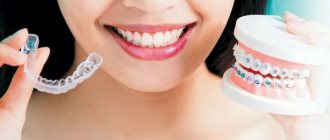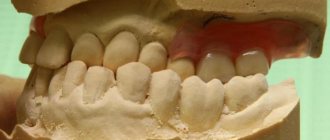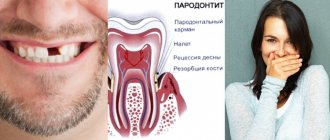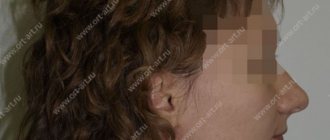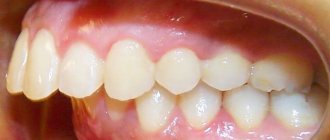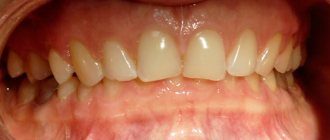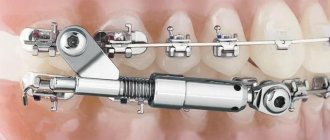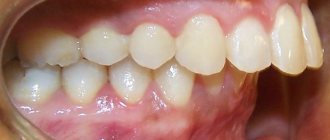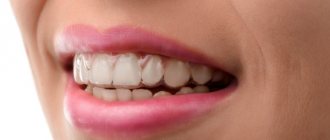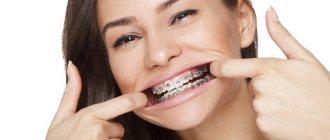766
Often a malocclusion is the cause of a state of discomfort and a feeling of dissatisfaction for its owner.
You can eliminate the source of the problem in various ways. A radical option for correcting minor defects, regardless of the patient’s age, is the installation of crowns.
Various types of pathological bite
According to statistics, up to 80% of people have various malocclusions
Mesial occlusion (progenia)
The presence of a mesial bite , characterized by an anterior position of the lower jaw relative to the upper jaw, can often be determined even visually - by the protruding lower jaw.
Deep bite
Holders of a deep bite , in which the incisors of the upper jaw overlap the incisors of the lower jaw by more than a third, can be visually distinguished by a deep mental fold and a shortened lower part of the face.
Distal bite (prognathia)
The external manifestation of a distal bite, in which the upper incisors are located far ahead of the lower ones, is the upper jaw unnaturally pushed forward.
Crossbite
A crossbite is characterized by a narrowing of the lower or upper jaw with a displacement of the lower jaw to the side. An external sign of such a defect is pronounced facial asymmetry.
Open bite
With an open bite, the teeth of the upper and lower jaws do not contact each other in some area.
Treatment principle
Prosthetics can be performed if the following defects are detected in the oral cavity:
- Too noticeable gaps between teeth.
- Too large or, conversely, small sizes of individual units.
- Chips, cracks, breaks.
For minor defects, you can get by with the installation of veneers or lumineers. They are very thin plates that are made of composite or porcelain. They completely cover the front surface of their tooth. It is first necessary to grind the tooth, this will allow the veneer to look more natural.
Installing a crown allows you to solve a wider range of problems, while pathologies can be more pronounced. Most often, installation is recommended for very large lesions, when it comes to complete tooth extraction.
The following factors can lead to malocclusion:
- Too early loss of back molars or primary front teeth.
- Presence of bad habits (thumb sucking, pacifier or other objects).
- Loss of teeth due to health conditions or injury.
If the crown is placed in a timely manner, the risk of disruption of chewing functions and digestive problems will be minimized.
Purpose of crowns:
- Protection from more serious damage.
- Additional protection for implanted implants.
- They can come to the rescue if you receive a very severe injury, as well as with severe caries.
Stages of treatment
- To correct the bite using this method, the patient will need to visit the clinic at least twice. Stages: First of all, a detailed diagnosis will be carried out and tests will be taken. This will allow you to determine the general condition of the oral cavity and determine the course of further treatment.
- After the dentures or veneers are ready, a person needs to go to the dentist to fix them.
- Any further visits to the doctor may be necessary if discomfort or pain occurs.
Removable dentures
Also, to eliminate bite problems, you can use more budget-friendly treatment options - installing removable dentures.
Prosthetics are recommended in the following situations:
- Shortened and disproportionate lower teeth.
- The upper teeth overlap the lower jaw by more than a third.
- Impaired diction, inability to pronounce certain letters.
- Too much worn enamel.
- A noticeable protrusion of the upper or lower lip.
- Strong crunching or clicking sounds when chewing.
Removable dentures are an ideal solution for patients with complete or partial edentia. A complete removable denture is ideal for the upper jaw; it is firmly fixed due to the suction effect. In the lower jaw, it is recommended to save at least one of your teeth, on which a partial denture can be attached in the future.
Contraindications
In some cases, a patient may be denied prosthetics, for example, due to:
Strong contact of teeth with the prosthesis, as a result of which they can wear out even more.
Rapid wear of the prosthesis. This may cause too much pressure and uneven loading.
It is important to understand that there are quite a few contraindications to the installation of dentures to correct the bite:
- A very strong violation. In such cases, only surgery can help.
- The patient has serious diseases, for example, tuberculosis, HIV infection, cancer, etc.
- The presence of dental problems, for example, inflammatory processes in the oral cavity or severe caries. These pathologies are rather relative, but they must be eliminated before any further intervention. Otherwise, the situation may only get worse.
Methods for correcting bite
In modern dentistry, teeth bite correction is carried out for patients of any age . Specific treatment methods are chosen individually, taking into account the type of bite, the degree of changes in the dentition, age, condition of the patient’s teeth and the entire body, his lifestyle, aesthetic considerations and other aspects. The duration of treatment also depends on many factors: the chosen treatment method, the condition of the teeth, the age of the patient, and is determined individually .
To correct malocclusion, special mouthguards and dental trainers , plates, and braces are used.
In some cases, surgical correction of the bite is performed.
Methods for correcting malocclusion
A reasonable question is how to correct the bite? An orthodontist treats this problem. The most common methods are: installation of braces, removable plates or mouthguards, trainers, surgery . Let's look at each of these methods in more detail.
Bracketless systems
Patients are wondering how to correct malocclusion without using braces? This method is considered not very effective and is used for minor curvature of the dentition . It involves the use of orthodontic structures:
- Vestibular plates
With their help, bite treatment is carried out in young patients (before the teeth are fully mature). Plates are installed mainly at night, they allow you to correct interdental gaps and keep teeth in the correct position.
Among the advantages, it is necessary to highlight the fact that this design is removable, it is easy for the patient to monitor oral hygiene and the plate can be removed at any convenient time.
Among the disadvantages, it is worth highlighting the ineffectiveness of use for patients in the older age group, as well as the longer duration of treatment (compared to braces).
- Trainers
These are special orthodontic structures that are made of silicone. When used, malocclusion is corrected; trainers help prevent the progression of the cause that caused the curvature of the dentition.
Among the advantages, it is worth highlighting the absence of discomfort during use, allergies or other unpleasant symptoms.
Trainers are recommended to be used during the day for 1 hour, as well as during sleep. The duration of use of such structures is selected individually for each person. In general, it is divided into several stages. In the first (from 6 months or more), the jaw position is corrected and the muscle structure is corrected.
At the next stage, hard trainers are used. After just three months of using this design, visible results are noticeable. The final stage of bite correction is wearing retainers, which help consolidate the effect.
- Orthodontic aligners
Such designs are considered more effective compared to the other two. They are very convenient to use; teeth bite correction occurs much faster than using reinners or plates. Mouthguards act directly on the dentition, so when making them, the dentist must carefully take plaster casts, this will allow for the production of a high-quality structure.
To reduce injury when correcting a bite, gradual use of mouth guards is used. It involves the manufacture of several structures that gradually eliminate curvature. When using mouth guards, you need to carefully monitor their hygiene.
The disadvantage of this treatment is that patients often forget to put them on at the right time. As a result, the process is delayed and does not always bring the desired result. In addition, the manufacture of mouth guards is considered expensive and not all patients can afford them.
Bracket systems
These designs are considered the most effective and affordable for correcting malocclusion in adults and children. The duration of treatment ranges from 6 to 36 months depending on the problem.
The disadvantages include , firstly, complex oral care, which requires the use of special pastes and brushes. Secondly, the unaesthetic appearance, especially when using metal structures. And thirdly, severe pain during the movement of the dentition when tightening the braces.
The main materials for the manufacture of such structures are:
- Metal . The most inexpensive and popular braces systems have an unaesthetic appearance among their disadvantages.
- Plastic . They are not highly durable and change color over time under the influence of pigments;
- Ceramics . Invisible, resistant to oxidation and staining. At the same time, they are distinguished by a high price;
- Sapphire . Compared to ceramic braces, they are less durable, require increased care during use, and are expensive.
In addition, there are self-ligating bracket systems; their only difference from metal ones is the complete absence of ligatures. This greatly simplifies the process of oral hygiene. Lingual braces are fixed to the inside of the teeth, they are invisible and easy to use. They are considered the most expensive designs.
The attending physician will help you choose the right design to correct the problem, according to the patient’s testimony.
When wearing braces, you must periodically visit the dentist, who will assess the degree of bite correction and tighten the ligatures.
Surgery
It is used in severe cases when other methods of correcting the bite do not bring results. Indications for surgery are:
- third degree malocclusion;
- serious deformations of the dental-jaw system;
- incorrect jaw proportions.
The patient undergoes dissection of the bone tissue in the area of curvature and their correction. This allows you to improve the processes of chewing food and swallowing, which, in turn, reduces the risks of developing unwanted complications.
The operation is performed under general anesthesia, the recovery period takes up to 21 days. Then you need to do exercises to develop your jaw. As a rule, after surgical correction, the dentist will prescribe mandatory wearing of braces for at least 6 months. The operation has a number of contraindications:
- pregnancy and lactation;
- patient age under 18 years;
- problems with the cardiovascular system;
- HIV infection;
- tuberculosis.
Disadvantages include a painful rehabilitation period and high cost.
Laser bite correction method
Today I use laser technology to straighten teeth. Doctors use laser bite correction at various stages of orthodontic treatment (surgery, installation of structures, etc.). The rays help prevent the development of inflammatory and infectious processes. Patients are interested in why this technique is needed?
When moving, gums are injured; laser bite correction helps speed up the regeneration process and prevents the entry of microbes.
It is important to note that this method is used in combination with other treatment methods, otherwise it does not bring results.
Correcting your bite with exercises
To straighten teeth, special exercises are used as auxiliary methods.
- With a deep bite, the patient must take a standing position with his feet shoulder-width apart. Raise your chin slightly upward and move your lower jaw away from you and back. One approach includes 10-15 repetitions.
- With an open bite, exercises are performed as follows: sit on a chair, take a small stick into your mouth and squeeze it with moderate force 5 times.
- When the upper incisors are crooked, the patient needs to “pout” and stretch his lips in a smile. This will slightly lengthen the upper lip and correct improper closure. The exercise must be performed 10 times.
- With a medial curvature, you need to lightly bite your lower lip and try to stick out the tip of your tongue and touch it to the upper row of teeth. Then close and open the jaws; while closing, you need to touch the palate with the tip of your tongue.
- To correct an oblique bite, exercises are performed in front of a mirror . The patient needs to open his mouth and try to move the crooked jaw as much as possible into the correct position. Then you need to close your mouth, keeping both jaws in the correct position. In the future, it is recommended to perform this exercise with your eyes closed.
It is important to note that exercises to correct the bite are prescribed to patients after surgery or when installing orthodontic appliances. By themselves they will not bring results.
Stages of bite correction
It is necessary to correct a dental malocclusion after a thorough examination of the oral cavity and the entire body, and diagnosis of dental problems. A painless and high-quality bite correction in Moscow can be carried out in the shortest possible time with maximum effect dentistry “22 Century” .
The process of correcting a bite takes place in three stages:
- At the first stage, the dentition is prepared for the installation of removable or non-removable structures;
- At the second stage, the bite is directly corrected using the selected method;
- The final stage - retention - is necessary to secure the teeth in the correct position.
How to correct malocclusion in children
It is easier to correct an overbite in childhood, but there are many reasons for its development. Thumb sucking, chewing habits, pressing the tongue on the teeth, holding the jaw incorrectly, and others are common. There are several methods to help children in this regard.
Using a pacifier
An orthodontic pacifier is primarily used not to correct the bite, but to ensure that it is formed correctly.
Its difference from the usual one is that the shape is as natural as possible, close to the structure of the female nipple. Therefore, sucking it is natural for the baby. It teaches the baby to hold his jaw and tongue correctly and helps to form correct nasal breathing. As a result, the correct bite is formed, which will help avoid problems in the future.
Using a plate
Plates are removable devices. They can and should be removed periodically to honor them and your teeth. Correction with plates in childhood is achieved quite effectively and quickly. They are intended for:
- holding teeth in the desired position;
- effects on the formation of jaw bones;
- stimulation or restriction of jaw development;
- regulation of the width of the palate.
The disadvantage of records is the age limit. Their use is considered optimal before puberty. As you get older, correcting your bite this way will become more and more difficult. In adults, plates are used only for minor defects.
Using staples
It is recommended to install braces after 8-9 years, the optimal age is 12-14 years. They are indicated for the following disorders:
- irregular shape of the jaw bones;
- too narrow or wide palate;
- abnormal growth of one or both jaws that is too fast or too slow;
- incorrect position of teeth;
- various bite pathologies.
Brackets are similar in design and operation to braces, but are less bulky and removable.
Using trainers
A trainer is a special tire made of elastic material. Their difference from other devices is that the action is not aimed at correcting the bite, but at eliminating the causes that influenced it.
When these causes are eliminated, the position of the teeth is normalized. The trainer helps the facial and chewing muscles work normally, resulting in the formation of a correct bite. The main time of wearing is night sleep. During the day, the device is worn during rest for a maximum of four hours. The device is slow and gentle and cannot correct severe malocclusions.
Correction of bite with braces
Structurally, such a system consists of arches connected by special locks - braces, fixed on the surface of the teeth.
One of the most common and effective orthodontic techniques is bite correction with a braces system. Structurally, such a system consists of arches connected by special locks - braces, fixed on the surface of the teeth. Due to the tension created by the arches, the teeth are shifted in the required direction and fixed.
Today, various braces systems are successfully used
- Metal,
- Sapphire,
- Ceramic,
- Lingual (installed on the inside of the dentition),
- Self-ligating (providing the most gentle and physiological correction of the position of the teeth).
The choice of a specific type of brace system is made individually for each patient.
Bite correction using the Invisalign system
One of the newest types of removable structures are transparent aligners of the Invisalign system.
One of the newest types of removable structures are transparent aligners of the Invisalign system . This treatment method involves manufacturing a set of special thin and transparent aligners for the patient using high-precision equipment. All mouthguards have slight differences in shape. The patient wears each one for approximately 14 days and then changes to the next one. As a result, the teeth gradually shift in the required direction, and the bite approaches normal.
Care instructions
Caring for the oral cavity after the installation of crowns should be continued in almost the same way as before prosthetics. It is necessary to brush your teeth with toothpaste twice a day - after breakfast and in the evening before bed. To prevent pieces of food from getting stuck, you should clean the interdental spaces with a special thread or floss.
Many patients after prosthetics believe that care in general has become even easier. After all, the surface of modern crowns is so smooth that pieces of food do not linger on them. You need to rinse your mouth with water after eating, use rinses with medicinal herbs and propolis.
It is recommended to pay special attention to chewing tough and hard foods. When installing crowns on the front teeth, you should absolutely not try to crack nuts or chew seeds. The enamel coating, like that of your own teeth, for all its strength, is not intended for such actions.
Watch the video to see how crowns can be used to change the shape of your teeth.
Surgical methods for correcting malocclusion
In the most difficult cases, the bite is corrected surgically . Indications for surgery are:
- Frontal or lateral open bite,
- Chin dysplasia,
- Facial asymmetry
- And other pathologies.
An operation to correct the bite, depending on the indications, allows, for example, to lengthen the jaw bone or remove part of it to ensure proper closure of the dentition. In modern dentistry, surgical interventions are performed painlessly under general anesthesia. All operations are performed primarily in the oral cavity, so there are no scars left on the patient’s face.
Popular questions
- What is the best method to correct a deep bite? For teenagers, a mouthguard or trainer will be optimal; for adults, braces with face arches will be the best choice.
- How to correct mesial bite? It is recommended to wear braces and use exercises as an auxiliary technique. And also surgery.
- What is the best way to correct a distal bite? For children, removable structures and gymnastics will correct the problem; for adults, braces cannot be avoided.
- What are the ways to correct an open bite? This type of malocclusion can be corrected with braces.
- Is it possible to correct a mesial bite without surgery? Yes, it can be corrected with braces and exercises as an aid.
- Which doctor should I contact? This is what the orthodontist does.
- How to correct your bite yourself at home? You can correct it yourself with the help of exercises, without consulting a doctor, only in children and with minor disorders.
- At what age is it better to correct the bite? Is it possible to correct it in 30-40-50 years? Up to what age is it possible? The optimal age for correcting malocclusion with the help of structures is 12-14 years. This is the time when permanent teeth have already grown and a bite has begun to form. You can do this at 30, but it will be more difficult. The older a person is, the less chance there is and the longer and more painful the correction will be. The operation can be performed at any age.
- Do I need to correct my bite? Yes, because in addition to a cosmetic defect, malocclusion leads to speech disorders, changes in the jaw joints and muscles, impairs chewing function, and therefore harms the body as a whole.
- Is it possible to correct an overbite with veneers? Crowns? Veneers are intended for a cosmetic effect; they cover “wrong” teeth, but do not correct them. Crowns are used to replace missing or damaged teeth.
- Is it possible to correct an overbite for free? Only with the help of exercises, in simple situations.
- Will tooth extraction help? Tooth extraction is indicated in some cases before installing braces or surgery. In most cases, tooth extraction, on the contrary, worsens the bite.
